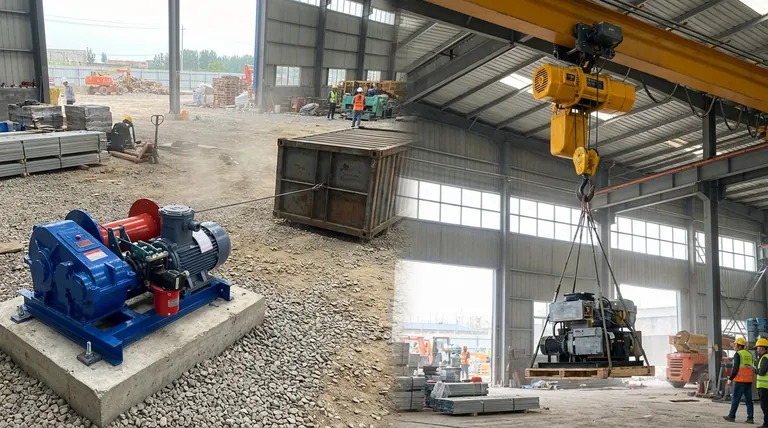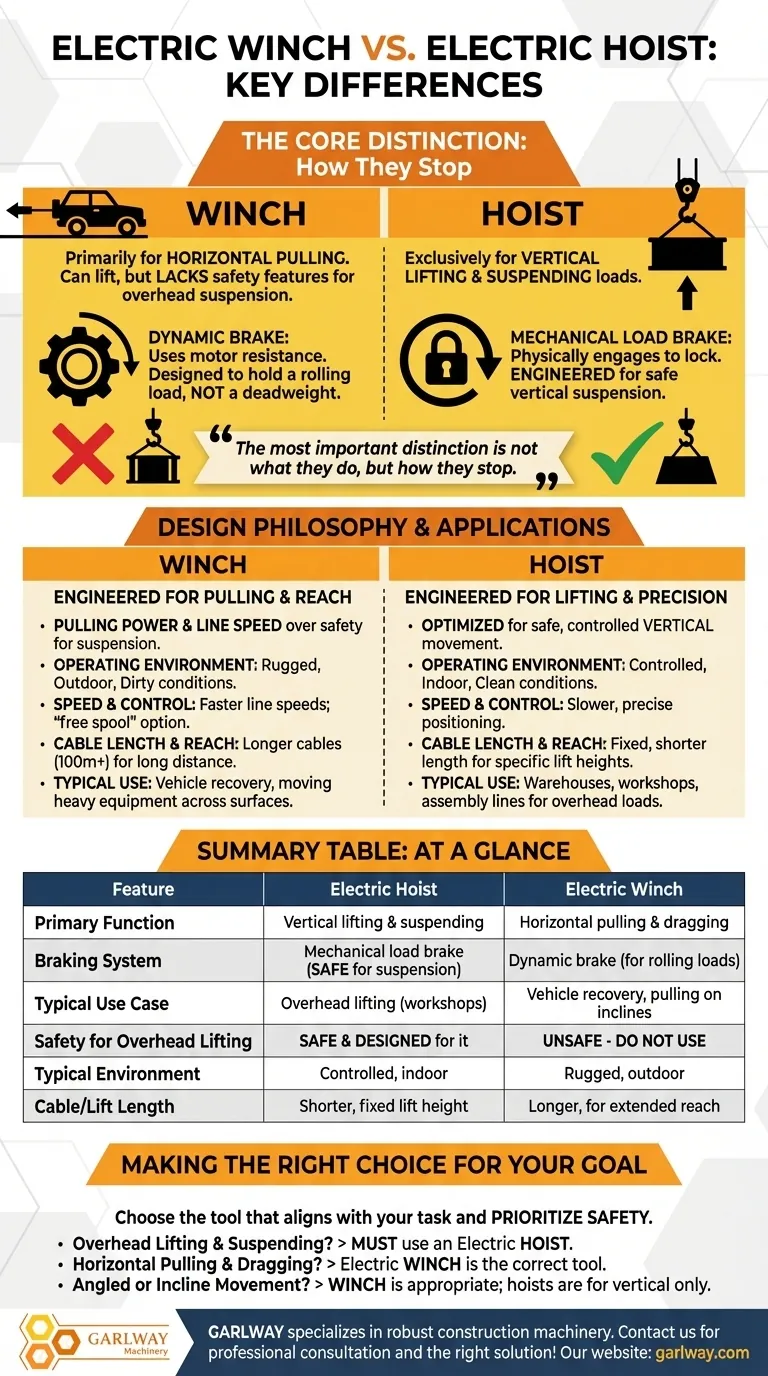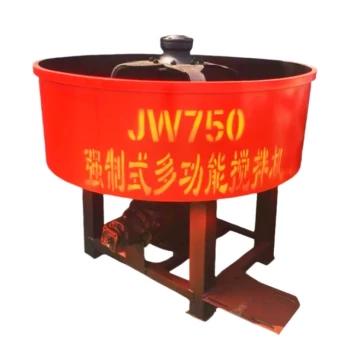At their core, the difference is simple: an electric hoist is designed exclusively for vertical lifting and suspending loads, while an electric winch is designed primarily for horizontal pulling. While a winch can lift, it lacks the critical safety features of a hoist, making it unsafe for suspending a load overhead.
The most important distinction is not what they do, but how they stop. A hoist uses a load-holding mechanical brake designed for safe vertical suspension, whereas a winch uses a dynamic brake designed to hold a rolling load, not suspend a deadweight load.

The Core Design Philosophy: Lifting vs. Pulling
Understanding the fundamental purpose behind each device clarifies nearly every other difference between them.
Hoists: Engineered for Vertical Suspension
An electric hoist is a specialized tool. Its entire design, from the gearing to the braking system, is optimized for one task: safely lifting and lowering a load directly overhead.
They are the standard choice in controlled environments like warehouses, workshops, and assembly lines where precision and safety in vertical movement are paramount.
Winches: Engineered for Horizontal Pulling
An electric winch is a versatile pulling machine. It is designed to pull a load across a surface, often over long distances or up an incline, such as recovering a vehicle or moving heavy equipment.
Their design prioritizes pulling power and line speed over the specific safety requirements needed to suspend a heavy object in the air.
The Critical Difference: Braking Systems
The single most important factor separating a hoist from a winch is the brake. This is not a minor detail; it is the central feature that dictates their safe use.
Hoist Brakes: Designed to Suspend
Hoists use mechanical load brakes. These brakes physically engage to prevent the load from slipping. Think of it like a locking mechanism that automatically engages the instant the motor stops.
This system is engineered to reliably hold a suspended load for extended periods without fail, making it safe for overhead applications.
Winch Brakes: Designed to Hold
Winches typically use dynamic brakes. This system uses the motor's own resistance to slow and hold the load. While effective for stopping a rolling vehicle on a slope, it is not a positive locking system.
These brakes are not designed or rated to safely suspend a deadweight load. They can slip under a sustained vertical load, creating an extremely dangerous situation.
Key Distinctions in Application
The core design philosophy and braking systems lead to several practical differences in how these tools are built and used.
Operating Environment
Hoists are generally built for clean, indoor environments where conditions are controlled.
Winches are almost always designed for rugged, outdoor use. They are constructed to withstand exposure to dirt, moisture, and fluctuating temperatures.
Speed and Control
Electric hoists often operate at slower, more deliberate speeds. This allows for precise positioning and controlled movement, which is critical when handling valuable or dangerous overhead loads.
Winches may offer faster line speeds, which is beneficial for quickly pulling in many feet of cable during recovery or pulling operations. Some may also feature a "free spool" setting to let cable out rapidly by hand.
Cable Length and Reach
Hoists are equipped with a fixed, relatively short length of wire rope or chain, as they are designed for specific vertical lift heights within a facility.
Winches, by contrast, come with much longer cables, often 100 meters or more. This gives them the reach needed for long-distance pulling applications.
Understanding the Trade-offs and Safety Risks
Confusing the roles of these two devices can lead to inefficiency at best and catastrophic failure at worst.
The Danger of Using a Winch as a Hoist
Never use an electric winch for overhead lifting or suspending a load. The dynamic braking system is not designed for this purpose and is not considered fail-safe.
A slipping brake could lead to the load dropping, causing severe damage, injury, or death.
When a Hoist is Too Restrictive
A hoist's specialization is also its limitation. It is fixed in place and can only perform vertical lifts. It cannot pull a load horizontally or diagonally.
For tasks requiring angled pulls or moving a load across the ground, a hoist is simply the wrong tool for the job.
Making the Right Choice for Your Goal
Selecting the correct device is a matter of prioritizing safety and aligning the tool with the task.
- If your primary focus is safely lifting and suspending a load overhead: You must use an electric hoist. There is no safe alternative.
- If your primary focus is pulling a load horizontally across a surface: An electric winch is the correct and most efficient tool.
- If your primary focus is moving loads at an angle or on an incline: A winch is the appropriate choice, as hoists are only rated for true vertical lifts.
Choosing the right tool begins with understanding that hoists lift and winches pull, a distinction dictated by their fundamentally different braking systems.
Summary Table:
| Feature | Electric Hoist | Electric Winch |
|---|---|---|
| Primary Function | Vertical lifting & suspending | Horizontal pulling & dragging |
| Braking System | Mechanical load brake (safe for suspension) | Dynamic brake (for rolling loads) |
| Typical Use Case | Overhead lifting in workshops, warehouses | Vehicle recovery, pulling loads on inclines |
| Safety for Overhead Lifting | Safe and designed for it | Unsafe - do not use |
| Typical Environment | Controlled, indoor | Rugged, outdoor |
| Cable/Lift Length | Shorter, fixed lift height | Longer, for extended reach |
Unsure which tool is right for your project?
Choosing the wrong equipment can lead to inefficiency or, worse, a dangerous situation. GARLWAY specializes in providing robust and reliable construction machinery, including electric winches and concrete equipment, tailored for construction companies and contractors globally.
Let our experts help you select the perfect tool for your specific lifting or pulling needs, ensuring safety and maximizing productivity on your job site.
Contact GARLWAY today for a professional consultation and discover the right solution for you!
Visual Guide

Related Products
- Electric and Hydraulic Winch for Heavy Duty Applications
- Electric 120V Boat Winch by Badlands
- 12000 lb Heavy Duty Electric Boat Winch
- Electric Hoist Winch Boat Anchor Windlass for Marine Applications
- Heavy Duty Electric Boat Winch Windlass Anchor
People Also Ask
- Can an electric winch be used as a hoist? Understand the Critical Safety Differences
- How does the electric winch work? Unlock the Power of Force Multiplication
- How is an electric winch powered? Unlock the Power Conversion System for Heavy Lifting
- How do I choose an electric winch? A guide to safe and effective pulling power.
- How to maintain an electric winch? Ensure Peak Performance & Reliability for Your Projects



















